Explorer ST goes to new lengths for 2020
Filed under: Weekly test drives, Autos
By John Gilbert
The SUV craze may come and go — although as we head into 2020 it looks like it has come to stay — but as names and shapes and sizes fluctuate, there will always be an Explorer.
Ford sells Explorers the way other companies can only dream about, and for 2020, the Explorer takes a large leap forward.
There are various Explorer models in the 2020 lineup, including a hybrid, and a so-called base 4-cylinder model, with all sorts of trim options up to the loaded Platinum maximum. The one that caught my eye at first, however, is the sporty ST model, and by good fortune, that is the one I got for my fkirst road test of the new Explorer.
If theres was a perfect time for examining how the new Explorer might cope with wintertime on the North Shore of Lake Superior, this has been the year for it. One report said that snowfall through mid-January is normally 30 inches, and this winter it was 70 inches.
To handle such challenges all the Explorers for 2020 ride on a new platform that is significantly different from the 2019 face-lifted version of the popular midsize SUV. Foremost is that the Explorer now rides on a platform that is rear-drive oriented, while all previous Explorers were on a front-wheel-drive platform. The new platform is long enough to house three rows of seats inside its 199.3-inch overall length, and it has a wider stance of 78.9 inches to better plant the vehicle, with the clear benefit to the spacious interior.
The ST has assorted sporty touches, such as the twin chrome exhaust tips on either side of the rear end, and four pipes should be enough to extract all the exhaust from the 3.0-liter V6, which is twin-turbocharged to run away from the very swift standard-issue Explorers, such as the XLT with its potent 300-horsepower/310-foot-pound 2.3-liter Ecoboost 4. The ST’s new 3.0 has a whopping 400 horsepower and 415 foot-pounds of torque.
That’s enough to send the Explorer ST from 0-60 miles per hour in a mere 5.3 seconds, and it can reach 100 in a quarter-mile dash in about 14 seconds. The base four-cylinder reaches 60 in a very respectable sub-7-second run, which is good for a vehicle of this size, but is left behind when the ST, despite 4,860 pounds, makes its run.
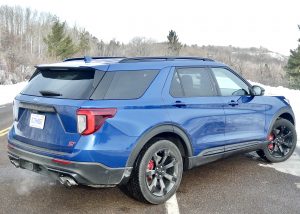
Roomy enough for optional third-row seats, and added storage, the Explorer also features 4-pipe exhaust on sporty ST model.
The ST is not just for show and sportiness. It does not shirk its work capability with a 5,000-pound towing weight, or its people-hauling requirements..
Part of the enjoyment of evaluating new vehicles is trying to guess at the reasoning behind the changes, or what might be coming next. I figure the Explorer has grown in size to take care of those folks who want a third-row seat, and also to make room for an all-new Escape, just out for 2020, and if moving the Explorer up a bit closer to the Expedition, it leaves more room for the Escape — and for the return of the Bronco to Ford’s stable. as an all-new SUV with an old name.
The Explorer has the refined compromise of being bigger and roomier but not handling bigger. It has a performance suspension package that lets it corner sharply and you can play with the settings with a knob on the console that goes from economy to normal to sport, and the sport setting works to tighten steering and firm up the suspension.
On the outside, short overhangs front and rear make for an interesting design and enhances any off-roading you might want or need to do. And the 21-inch alloy wheels — black on the ST — respond well to the urgings of the 10-speed automatic transmission, which shifts often and smoothly, but which also can hold its shifts if you’re in sport.
The Explorer ranges in price from $37,000 up to the ST test vehicle’s stiff tag of $59,520, and while you can find numerous midsize SUVs for that or less, you have to experience the new Explorer to realize it feels like it can compete with larger and costlier SUVs. And, without question, the bulk of that money’s-worth is on the inside, where creature comforts surround you in every way in ST trim.
The leather bucket seats, with contrast stitching, are firm and comfortable, with buckets in the front and second rows that are heated. Rumor has it that the fronts are also cooled, although in January in Northern Minnesota, that’s one of those features you don’t bother testing. The spaciousness of the front seats becomes remarkable in the second row, where the seats have plenty of legroom.
The neat part is that at the push of a button, you can make the seat slide fore and aft, and the backrest folds down at another touch. The height of the second row buckets gives them room to fold out of the way for entry to the third row bench seat, which works, although might be reserved for kids or small adults. Of course that third row seat folds down, and enlarges the storage space under the hatch.
Back up front, the driver gets both serviced and entertained from the cockpit-style layout. A large, horizontal instrument cluster greets you as you enter with a beautiful and artistic vision of mountains and billowing clouds in the sky, and, if it’s late enough, a gigantic moon is rising from out of the mist. Of course it changes over to serious business when you start the car with the push-button located on the horizontal space between the console and the dashboard.
Then you check the navigation screen for information, and be prepared: At 10.3 inches, that vertical screen is about the size of an iPad, and it loaded itself up with information, including the normal audio or climate control settings. When you shift into reverse, you not only get the direct rear-facing camera shot of where you’re heading, but you also get the overhead 360-degree view of the vehicle — complete with a darkened area that indicates you have the ST package’s double-size sunroof, which Ford calls a moonroof.
The high-tech B&O audio system is also something special, sending lots of sounds to 14 speakers in the ST, and the separation of sounds from those speakers puts this whole system up with the highest level of vehicle audio.
Living in the snow belt gives you some special needs, and the Explorer ST handles them all with safety features including park assist, automatic LED headlights that cut through the snowflakes in a storm and turn night into virtual day. A small feature is the capless gas filler. When it’s below zero, and you’re at the gas pump, you plug in your credit card, grab the nozzle, flip the filler door open, and just stick in the nozzle without taking off your other glove to unscrew a cap.
My wife, Joan, liked everything about the Explorer ST, but if she had to pick a favorite item, it might be that while standing in the kitchen, looking out at the Explorer parked 100 feet away, under the result of an overnight snowstorm, you just hit the key fob to watch its lights blink and the remote starter firing up that engine. Take a few minutes to bundle up for the short walk, and the Explorer is warmed up, seat-heater and defroster already warm, and you’re all set to go to work, to the mall, or to go…Exploring.
Polished 2020 G70 gives Hyundai a step-up sedan
Filed under: Weekly test drives, Autos
By John Gilbert
U.S. car buyers have completely converted their attention from traditional sedans to SUVs, trucks and crossovers at such a pace that it’s futile for companies to keep making those old-fashioned conveyances. We all know that.
Or do we? Hyundai begs to differ, despite the overwhelming shift in sales figures and profit, the South Korean giant has presented us with vehicles like the 2020 G70, under the newly separated Genesis luxury line. What are they thinking?
Sales numbers show that even the most stalwart cars, like the Camry, Accord, and Civic, have been displaced by SUVs like the RAV4 and the CR-V, which are now the leading sellers for Toyota and Honda, respectively. Same with Nissan, where the compact Rogue SUV is the top selloer. So convinced are car-makers that giants such as Ford and General Motors have halted production of a lot of cars that used to carry their colors into annual sales competition.
And then there’s Hyundai, which has zoomed up to the top echelon in technology, safety and popularity to become a giant in automotives, over the last 10 years. And while Hyundai seems to be in a hurry to get to the top, it is not so much in a hurry to give up on cars. Sedans, even. Hyundai, in partnership with KIA, continues to reach higher into the hallowed ground of SUVs, but they also continue to make very impressive sedans. And they’re reaching for more.
For 2019, Hyundai introduced the Genesis G70, a 4-door sedan version of its flashy coupe, and at the most reasonable end of the three cars — G70, G80, and G90 — with which it has endowed its new and separate high-end Genesis brand. As a brand new model, the G70 surprised many in the industry by being named Car of the Year. KIA had come out with the highly successful Stinger a year earlier, so the platform was there, and Hyundai shortened it to more compact dimensions, and filled it up with elements that are aimed at luxury and sportiness, and achieved that hard-to-achieve combination.
Up on Lake Superior’s North Shore, outside of Duluth, Minnesota, we got an early start on our winter-that-never-ends season where drivers had to contend with heavy snow and cold long before 2019 ended, so I was pleased to get a week-long test drive in a Genesis G70, and it was the loaded G70 AWD 3.3T Sport, which gets your attention immediately, with a sticker price of $53,245.
That strikes you as a lot for a company that started out, and climbed, by building economy cars, then economical cars, adding style, then luxury, then sport, but keeping the sticker price far less than you’d assume, for all you’re getting. Turns out, the new G70 does exactly that, punching above its weight class by far, considering it starts with a base price of $46,650, and is a very impressive entry-luxury car at that price.
Once you drive the car — particularly after a blizzard hits — you appreciate all it offers and how much attention has been paid to make you comfortable and secure, while also holding the hammer of high performance. A turbocharged V6 with 365 horsepower and 376 foot-pounds of torque, delivered through a superb all-wheel-drive system, offers plenty of performance in a sleek, BMW-esque shape.
The usual high-end Hyundai technology is everywhere, including the outstanding lane-departure and lane-centering devices, all the connectivity you could want, simple execution of top-end luxury, and style — along with the high-grade steel placed strategically throughout the platform.
Real-world luxury starts with the Nappa leather bucket seats that are heated front and rear and offer support and comfortable firmness. And it goes right on through the head-up display of redundant information in the driver’s line of vision and to the brilliantly lighted outside, with LED headlights, taillights and daytime running lights. The headlights have auto-dimming, naturally, because the test car came equipped with all the standard equipment as well as the Elite package, with adaptive lighting, parking sensors and parking assist, plus the Prestige package, and the Sport package. with the surround video screen monitor, quilted Nappa leather seats and head-up display, and the Sport package, with 19-inch black alloy wheels, electronic suspension, and the dark chrome grille.
The wheels are larger than standard, and measure 225-40 19 front and 255/35 19 rear — just so you won’t be tempted to do the easy seasonal front-to-rear swap. Is that necessary? Not sure, but I often accuse designers and engineers of successfully avoiding the need to buy after-market tires or they wouldn’t add such complexities to car ownership.
The powertrain is a gem, with the 3.3-liter V6, twin turbocharged to send 365 horsepower and a whopping 376 foot-pounds of torque to all four wheels. An 8-speed automatic governs the power to all four wheels, which is something you appreciate mostly in Winter driving when “winter” is spelled with a capital W. The transmission shifts smoothly all the way from 1 through 8, and can be manually overridden by paddles on the steering wheel to execute the rev-matching shifts.
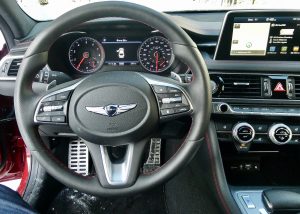
Assorted switches on steering wheel, including shift paddles, are efficient and ergonomically sound.
All that power makes the G70 a kick to drive, although it never feels like a hot rod, maybe because of all the luxurious accoutrements and computer gadgetry. But get on it hard and you find it has plenty of punch that complements its insistence on staying firmly planted in cornering, and smooth at freeway speed.
The twin turbos make it easy to get on it hard, and difficult to get on it easy, so the EPA estimates of 17 city and 25 highway usually flank what you’re actually attaining. I didn’t get the G70 out on the freeway for any kind of trip, so I can’t say that we ever cruised at 25 miles per gallon or more, but it was easy to get 23 or 24 in city driving, which makes me believe you could get close to 30 with sustained cruising and mellow throttle usage.
The G70 is not the luxury liner the G90 is, but it does have all the luxury anyone could seek, and it’s a sporty luxury combined with crisp handling and that potent power, which gives it a sporty edge that most luxury cars don’t strive for. Plus, all the electronic gadgetry works well and efficiently, satisfying the desires of the technocrats. All those things working in harmony puts the G70 on a plane that would require comparison shoppers to check the BMW lineup, or Audi or Mercedes, but German, for sure.
Hyundai didn’t earn the right to have its new G70 mentioned in the same sentence with BMW, but it has earned that status by remaining committed to building cars, from the subcompact Accent to the compact Elantra and extremely slick midsize Sonata, and on up to the Genesis models. The company is not being overly bold, but it has maintained the belief that sedans are not going away.
While buying into the profit margins of SUVs, at Hyundai they believe that it may be cyclical, and while many SUV buyers are happy with their purchases, they may prefer to revisit the sedan market once they revisit the varieties for their second vehicle, where the right sedan might beat having two SUVs.
If that happens, and plenty of market research indicates it well could, a good number of those buyers might want a sedan that is a cut above others in features, luxury or sportiness. And with the G70, Hyundai already has a proven winner at a price tag that is not all that expensive, after all.
Tiguan goes to greater lengths to impress
Filed under: Weekly test drives, Autos
By John Gilbert
The tradition of making cosmetic changes to make a new car look artificially new appears to be over. Auto companies have finally realized that if they build a model with a widely accepted design, staying with it is not a bad thing.
That seems to have been the belief of Volkswagen for years, particularly when you consider the Beetle, or the Golf. It also has had an impact on VW’s compact Tiguan SUV, which is more into refining upgrades than startling alterations.
I’ve written about the Tiguan before, because it is a solid, substantial, safe SUV, capable of hauling a good amount of stuff as well as people, and giving you a secure feeling of driving and riding, which is important to families. Over two generations of Tiguans, there wasn’t a lot of change for change sake, but in 2018, VW made a somewhat startling move.
The decision was made to lengthen the somewhat stubby Tiguan by more than a foot, and offer a their-row passenger seat as an option. The seats fold down, greatly expanding luggage capacity, and it made the third-generation Tiguan stand out for having grown substantially.
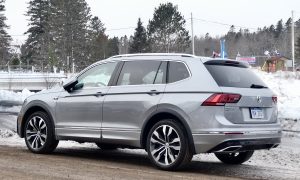
The Tiguan revisited Hwy. 61 to attend the Norwegian winter festival of Julebyen in Knife River, Minneaota.
VW did a great job of stretching out the body and making that extra room useful on the inside, without looking grotesquely bigger on the outside. It was almost unnoticeable unless you parked one alongside one of the first two generation models for contrast.
At first, always seeking the most compact versions of anything, my impression was that the new and longer Tiguan made me appreciate the older and shorter model more. Both were sold, but the shorter one seemed sportier. It was evident, however, that the shorter model would only exist until the supply ran out, then all Tiguans would be built longer.
I recently had the chance to spend a week in Northern Minnesota with the 2020 Tiguan, and we did find ways to put the extra storage space to good use. The model we tested was the SEL R-Line, loaded up and second only to the SEL Premium in VW’s five-model pecking order.
For 2020, the Tiguan SEL adds some technology and features, many of them dealing with connectivity, and safety. Blind spot monitoring, rear cross-traffic alert, forward collision warning and emergency stopping aid, pedestrian detection, the optional third-row seat, and a Fender premium audio with nine speakers added to the pleasant environment of the Tiguan SEL.
The Tiguan price is comparatively steep, but spending up to $38,000 assures you of comfort and convenience added onto the standard safety. The Tiguan hasn’t grown so much that the tried and trusty 2.0-liter dual overhead camshaft VW 4-cylinder can’t handle the extra size. Especially when bolstered by a turbocharger to attain 184 horsepower. The test vehicle also had 4-Motion, which is VW’s all-wheel-drive system.
The test Tiguan also added remote start and rain-sensing wipers, along with wireless charging, the latest cell-phone compatibility, and a large sunroof, plus a 1,500-pound towing maximum, which is adequate for fishing boats or light camping trailers.
Competition for the Tiguan comes from vehicles such as the Mazda CX-5 — one of my personal favorites — and the Honda CR-V, Nissan Rogue, and Ford Escape, among others. The proliferation of compact SUVs makes this a crowded segment, although as a longer vehicle, the Tiguan can also move up to challenge larger midsize SUVs such as the Explorer and the General Motors variants, and Tiguan still holds its head high as a premium entry.
Driving the Tiguan gives you the feeling of security in all situations. We had a good old-fashioned North Shore snowstorm during my time with the Tiguan, and it always provided a calming effect — safety, security, and the solid confidence in its ability to get you through anything to get home.
Comfort from the leather bucket seats of the upper-crust SEL R-Line, with its sporty touches, and the third row seat is not to be taken lightly. It’s not particularly roomy for adults in the way-back, but it is capable, and with the 4-Motion models, you get 5-7 occupants. With all three rows in place, there is 12 cubic feet of storage behind the third row; folding down the third row obviously increases that, and if you fold down both the second and third rows, you have 65.7 cubic feet of storage.
In its renovated product line, Volkswagen is streamlining things with brisk and efficient engines. The 2.0 Turbo is the only one available in the Tiguan, and it is capable of being quick enough and still delivering mid to high 20s in miles per gallon. Some of the modern touches are more than gimmicks, things like lane-departure warning and rear cross-traffic alert, and while you get a larger navigation screen with the SEL, you appreciate those features once you drive with them.
In years past, there might have been two different 4-cylinder engines and a V6 available, but the do-all 2.0-Turbo overlaps its assets to cover all demands. You can find faster SUVs, and more economical ones, but it difficult to think of one that offers both sufficiently, plus the size, room, safety and security, and the promise of that solid build and style.
Style is purely subjective, of course, but in my mind, the sleek grille and the smooth look without being gimmicky are complemented by a neat crease along the side. And if the realization occurs to you that you needn’t trade in your vehicle every two years to keep up with always altered designs, you admire the stately look of the new Tiguan even more.


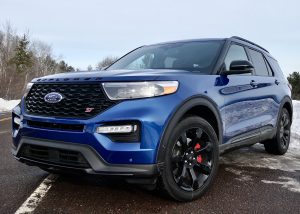
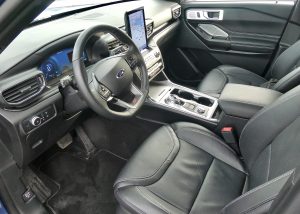
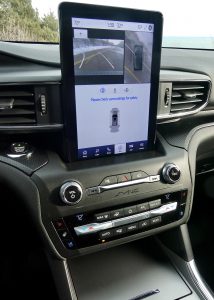
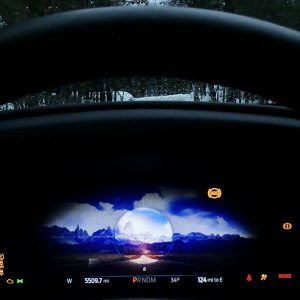
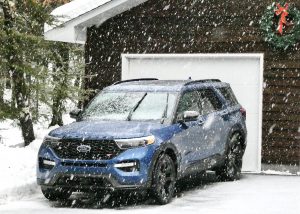
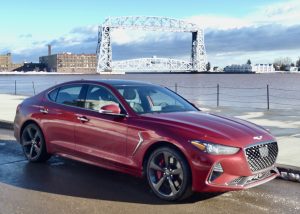
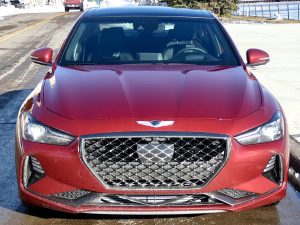
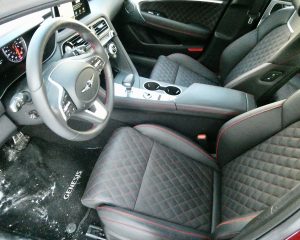
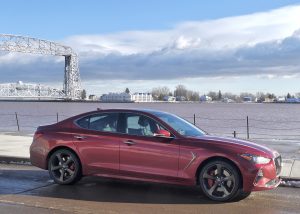
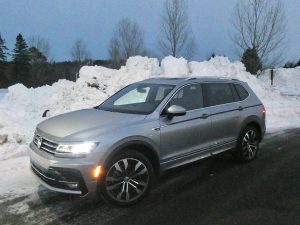
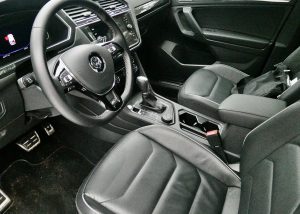
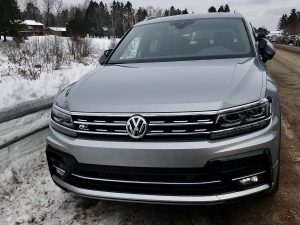
 John Gilbert is a lifetime Minnesotan and career journalist, specializing in cars and sports during and since spending 30 years at the Minneapolis Tribune, now the Star Tribune. More recently, he has continued translating the high-tech world of autos and sharing his passionate insights as a freelance writer/photographer/broadcaster. A member of the prestigious North American Car and Truck of the Year jury since 1993. John can be heard Monday-Friday from 9-11am on 610 KDAL(www.kdal610.com) on the "John Gilbert Show," and writes a column in the Duluth Reader.
John Gilbert is a lifetime Minnesotan and career journalist, specializing in cars and sports during and since spending 30 years at the Minneapolis Tribune, now the Star Tribune. More recently, he has continued translating the high-tech world of autos and sharing his passionate insights as a freelance writer/photographer/broadcaster. A member of the prestigious North American Car and Truck of the Year jury since 1993. John can be heard Monday-Friday from 9-11am on 610 KDAL(www.kdal610.com) on the "John Gilbert Show," and writes a column in the Duluth Reader.